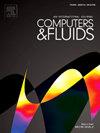A freestream preserving algorithm for the flux reconstruction method implemented on tetrahedral element
IF 2.5
3区 工程技术
Q3 COMPUTER SCIENCE, INTERDISCIPLINARY APPLICATIONS
引用次数: 0
Abstract
In computational fluid dynamics, curvilinear elements are frequently used to fit boundaries. Metric terms are involved by the map from these curvilinear elements to the standard reference element. If these metric terms are calculated inappropriately, the solutions may be incorrect or even divergent. It is well known that the freestream solution could be used to examine whether the metrics are discretized correctly or not. Namely, the metric terms must be computed in such a way that the freestream could be preserved, which is known as the freestream preservation problem. Although this problem has been studied extensively in the finite difference approach, there are still unanswered questions in the high-order schemes for the unstructured mesh, such as the discontinuous Galerkin (DG) method and the flux reconstruction (FR) algorithm. The existing research about the freestream preservation property for these high-order schemes mainly focused on the unstructured hexahedral element. Although some algorithms had been extended to the unstructured tetrahedral element (Chana and Wilcox, 2019), it remains unclear whether the conditions to preserve freestream on the tetrahedral element agree with those of the hexahedral element. In this paper, we extend the work of Abe and his colleagues (Abe et al., 2015) on the freestream preservation problem in the FR method from the unstructured hexahedral element to the tetrahedral cell. The algorithms of both the non-conservative and symmetrical-conservative metrics occurred in their research have been extended to the tetrahedral element in our research. We also analyzed the conditions under which these algorithms could achieve freestream preservation property and found that they are not equal to those of the unstructured hexahedral cell. If and are used to respectively represent the order of solution and grid, the algorithm constructed in the non-conservative form could preserve freestream when for the hexahedral element, as depicted by Abe et al. (2015). However, this condition becomes on the tetrahedral element according to our research. In the symmetrical-conservative metrics, this condition changes from on the hexahedral element (Abe et al., 2015) to on the tetrahedral cell. Namely, compared to the hexahedral element, these conditions are relaxed for the tetrahedral element. To verify our findings, two three-dimensional cases are performed. The results of these numerical simulations have confirmed that the algorithms constructed in our research are successful and the corresponding conditions are correct.
在四面体单元上实现了一种自由流保持通量重建方法
在计算流体动力学中,经常使用曲线单元来拟合边界。从这些曲线元素到标准参考元素的映射涉及到度量项。如果这些度量项计算不当,解可能是不正确的,甚至是发散的。众所周知,自由流解决方案可用于检查度量是否被正确离散。也就是说,度量项必须以一种能够保存自由流的方式计算,这被称为自由流保存问题。尽管这一问题在有限差分方法中得到了广泛的研究,但在非结构化网格的高阶格式中,如不连续伽辽金(DG)法和通量重建(FR)算法,仍然存在尚未解决的问题。现有的高阶格式的自由流保存特性研究主要集中在非结构化六面体单元上。尽管一些算法已经扩展到非结构化四面体单元(Chana和Wilcox, 2019),但仍然不清楚四面体单元上保持自由流的条件是否与六面体单元的条件一致。在本文中,我们将Abe及其同事(Abe et al., 2015)关于FR方法中自由流保存问题的工作从非结构化六面体单元扩展到四面体单元。在他们的研究中出现的非保守度量和对称保守度量的算法在我们的研究中被推广到四面体元。我们还分析了这些算法实现自由流保存特性的条件,发现它们不等于非结构化六面体单元的条件。如果用P和Q分别表示解的阶数和网格,则对于六面体单元,以非保守形式构建的算法在P≥2Q时可以保持自由流,如Abe et al.(2015)所述。然而,根据我们的研究,这个条件在四面体元素上变为P≥2(Q−1)。在对称保守度量中,该条件从六面体单元上的P≥Q (Abe et al., 2015)变为四面体单元上的P≥Q−1。也就是说,与六面体单元相比,四面体单元的这些条件是宽松的。为了验证我们的发现,进行了两个三维案例。这些数值模拟的结果证实了我们所构建的算法是成功的,相应的条件是正确的。
本文章由计算机程序翻译,如有差异,请以英文原文为准。
求助全文
约1分钟内获得全文
求助全文
来源期刊

Computers & Fluids
物理-计算机:跨学科应用
CiteScore
5.30
自引率
7.10%
发文量
242
审稿时长
10.8 months
期刊介绍:
Computers & Fluids is multidisciplinary. The term ''fluid'' is interpreted in the broadest sense. Hydro- and aerodynamics, high-speed and physical gas dynamics, turbulence and flow stability, multiphase flow, rheology, tribology and fluid-structure interaction are all of interest, provided that computer technique plays a significant role in the associated studies or design methodology.
 求助内容:
求助内容: 应助结果提醒方式:
应助结果提醒方式:


